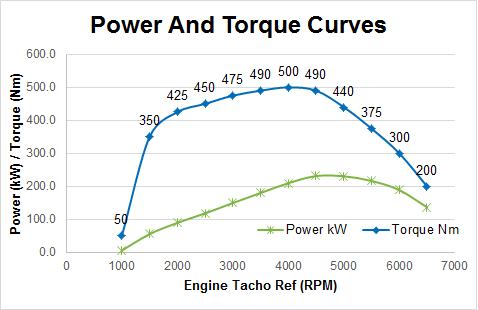At the end of the first post in this series (page8). We established that knowing the power curve without a reference speed isn't a great deal of help if we want an accurate calculation of the the tractive effort in each gear.
I'll try to roll together methods 2 and 3 into this one post.
The Goal
To find the tractive effort curves for a car with a 5 speed transmission
2. Power Curve with Tacho and Speed Reference
To get a reference speed, we can relate a road speed to a specific rpm in each gear.
To do this, we can take a reading of the road speed at a set RPM in each gear, or drive at a constant speed and measure the RPM in each gear. You will sometimes see this references as road speed/1000rpm
In this case we measured:
Gear 1 - 2.59m/s / 1000rpm
Gear 2 - 4.40m/s / 1000rpm
Gear 3 - 6.53m/s / 1000rpm
Gear 4 - 8.27m/s / 1000rpm
Gear 5 - 10.2m/s / 1000rpm
N.B. Relating road speed to engine speed in this way, is giving us the overall gearing ratio (including gear, final drive and rolling circumference).
We can now plot the power availability in each gear

From the plot above we know the exact power availalbe at all road speeds in gear we can again use:
Power = Force * Speed
To generate the following tractive force curves.

This gives a more accurate acceleration profile of the car both in each gear and throughout it's operating speed range.
Please take note of the profile of the tractive force curve in each gear.
3. Using the Torque Curve to generate tractive effort curves at the wheel
From the first post. We know the torque curve that is associated with the power curve.

We can find the overall gear ratio by using the method above using reference speeds and the wheel size.
In this case Rolling circumference is 2, and by geometry the Rolling Radius is 0.31831
By multiplying the reference speeds above by 60 (to convert seconds to minutes), then deviding by 2 (wheel circuference). We can calculate the overall transmission ratio (gear and final drive) Which Gives:
Ratios
Gear 1 - 12.87
Gear 2 - 7.58
Gear 3 - 5.10
Gear 4 - 4.03
Gear 5 - 3.26
Factoring the engine torque curve by this ratio and the rolling radius we get the following traction curves:

As you can see both power and torque methods produce exactly the same traction curves, so it really doesn't matter which one you use. You can simply pick the most convenient method based on the information available at the time.
It's also of interest to note that the traction curves in each gear are some function of the engine torque curve.
i.e The profile of which you accelerate in gear is the same profile as the engine torque curve.
I'll create a 3rd post. That uses some methods above to explain some of the common questions and phrases that have been used. I hope there aren't too many errors in the above post. Comments and questions welcome!






